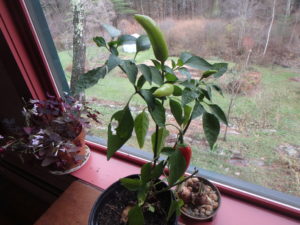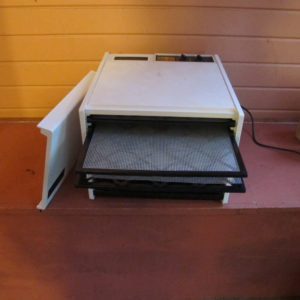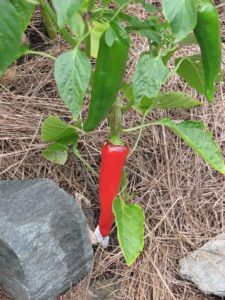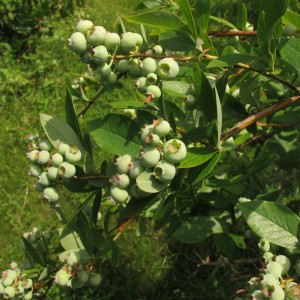It’s Time to Think about Hot Peppers
I love hot and spicy peppers. As a young man I lived in West Africa for nearly 10 years, first as a traveler, then as a Peace Corps volunteer and Peace Corps Country Director. I lived in Cameroon and Mali where hot peppers were an integral part of the diet. If peppers are hot enough, they make you sweat – which cools you down. That’s good, as most African villages didn’t have electricity back then for fans or air conditioning.
Hot peppers are rated in Scoville Units to give you an idea of how hot they are. They are named after Wilbur Scoville, an Englishman who tested peppers in the early 1900s. In my first book, Notes from the Garden, I wrote, ”I like to imagine him serving little tea sandwiches to proper English lords and ladies, but with peppers beneath the watercress. Did he measure heat by face color or expletives?” I imagine he actually measured capsaicin content as it is the compound that gives peppers their kick.
Hungarian wax peppers, my mildest hot peppers, are rated for 300-700 Scoville units. Jalapenos and Cayennes run 3,500 to 6,000 units, while Habaneros can reach 200,000 to350,000 units. Be sure to wear glove if you handle very hot peppers – a little of the oil or a speck of dust in the eye (or another sensitive area) can be very painful. I’ve read that the more stressed a pepper is, the hotter it is – hence the range for any variety – I find they vary considerably from year to year.
I dry most of my hot peppers in a food dehydrator so that I can grind them into a powder to add just a little bit to a dish. I use my coffee grinder to do that, after I have dried them until they are brittle. That makes for an interesting cup of java, too, after I’ve ground the peppers.
Most hot peppers would rather be growing in Mexico or southwest France than in New England. They like plenty of sunshine and consistently hot temperatures. They don’t like heavy wet clay soils – so when planting, amend the soil, if necessary, with compost to lighten it up. But never add fertilizer to peppers. If you do, you will get big leafy plants, but few peppers. That’s true for sweet peppers, too.
I have a friend, Brian Steinwand, whose mouth must be made of leather. He can eat habanero peppers (one of the hottest kinds) like they are candy. He touts their fabulous flavor, but for most of us that flavor comes with too much heat to be pleasant.
This year I discovered a habanero that allegedly comes with all the flavor, but much less heat. It’s called “Roulette” by Johnny’s Selected Seeds, and is touted to have “a sweet, floral flavor without the traditional fire we expect from a habanero.” Of course that name makes me wonder if a few of the fruits will have the bite of a real habanero.
My favorite hot pepper is the “Espellette” pepper from southwest France. Like champagne, the name is controlled by the French government, and these peppers are only supposed to be grown in 11 specific villages. But the peppers are readily available in the Bordeaux region, and I’ve discovered that seeds saved from them can produce great peppers even in New England. Last year mine did not produce well as I started the seeds too late, I think. Or perhaps the weather was wrong.
Each year I like to try new varieties of the vegetables I like. Along with Roulette, a pepper I shall try this year is called “Amazing 2”, also from Johnny’s Seeds. According to the description in their catalog, this is a thick walled pepper, and needs a dehydrator to dry it. It is a traditional Korean drying pepper, and is said to be good for making kimchi, but has a lower heat rating than most. It’s said to be warm, not hot.
Like Roulette, Amazing 2 is a hybrid pepper, so I will not be able to save seeds. Hybrids are created by crossing 2 parents of different genetic makeup. But their seeds don’t breed true, so you have to buy new seeds when you use them up. But even a small packet of seeds will produce plants for 2 or 3 years if you only want a few plants. I find most seeds are viable for 3 years.
One nice thing about growing peppers is that they are sociable. By that I mean, they like to hang out together. Most peppers like to actually touch leaves with other peppers when the plants are mature, so I plant them just a foot apart – so they don’t take up much garden space. Of course if you plant 2 or more varieties, they will hybridize, so I don’t save seeds – who know what I would get. In years when I grow Espellette peppers and want to save seeds, I grow no other peppers anywhere in my garden, hot or sweet, to keep the seed line pure.
January is too early to plant any seeds, but I enjoy reading the seed catalogs or web sites, and ordering early. And before too long, it will be time to start them indoors. Meanwhile, I think I’ll go make a hot winter stew. Hot with peppers, that is!
Henry can be reached at henry.homeyer@comcast.net.
There’s Plenty to Do in the Vegetable Garden
I got an inquiry recently about vegetable gardens: is it too late to start one? In a word, no. But you will have to act quickly if you want one because most garden centers are just about sold out of vegetable starts, though many still have large individual tomato plants in pots for sale. But even if you don’t find 6-packs of tomatoes or peppers for sale, many things can be started now by seed (though it is too late to start tomatoes and peppers from seed).
I planted 6 Hungarian wax hot pepper plants in early June, and quite frankly they look awful. Peppers like hot weather, and we haven’t had as much as they’d like. If I see some nice hot pepper plants for sale I’ll buy them – but I’ll plant them in big planters, not in the ground. Then if they are doing well in the fall, I can bring them indoors when it starts to get cold. I know a fellow who keeps hot peppers growing inside most of the winter.
Broccoli does well in the fall, and I often plant it by seed in mid-July. I prefer to start seeds in 6-packs rather than in the ground, but either way works. By planting seeds in multi-packs I can keep an eye on the seedlings better, and control how much moisture they get.
Lettuce is a crop that needs regular re-planting. I like to start lettuce every couple of weeks all spring, summer and fall. Read the seed catalogs or packages carefully – some kinds of lettuce do better in the heat of mid-summer than others, and most companies will tell you which varieties do best in the heat. I recently called Johnny’s Selected Seeds in Maine (www.johnnyseeds.com) to see what they recommend. I was told that Romaine types are the most heat tolerant, things like ‘Muir’, ‘Concept and ‘Nevada’. I’m trying these, and I’ll report back in the fall on how mine did.
If you want to grow lettuce in mid-summer, plant it in places that get some shade in the afternoon – on the east or north side of the corn or tomatoes, for example, or shaded by a tree or building. And be sure to keep the soil moist – you will need to water lettuce during hot, dry times – especially just after planting seeds.
You can start carrots and beets for fall crops now, too. Carrots need a deep, loose soil, so work in plenty of compost and pull out the rocks before planting to get long, beautiful carrots. Raised beds work great for carrots because you can easily build up a deep fluffy soil.
It’s good to thin and weed spring plantings of carrots and beets by the Fourth of July. They should be thinned to an inch apart by now. And carrots, which require quite a lot of nitrogen in the soil for best results, can benefit from a topdressing of fertilizer now. I sprinkle some Pro-Gro organic fertilizer alongside each row of carrots, and then lightly scratch it in with my favorite weeding tool, the CobraHead (www.CobraHead.com).
It’s not too late to plant a (second) crop of green beans, either. Plant seeds directly in the ground an inch deep and 3 inches apart in staggered double rows that are at least 18 inches apart. Or you can plant pole beans, which take up less garden space and keep on producing all summer. Bush beans produce a heavy load of beans over a 3 week period, and then they’re done. That’s great for freezing, but I like some pole beans for daily consumption. ‘Kentucky Wonder’ is the tried-and-true classic pole bean.
Cilantro and dill are herbs that tend to bolt (go to seed) fairly quickly. But you can re-plant seeds now for a constant supply. I forgot to plant basil seeds this spring, but bought some nice young plants in 4-packs recently. But if your plants are big and are starting to flower by now, be sure to pinch the tops back. Basil gets bitter when it flowers. The more you pinch it back (or cut off big sections of leaf), the more it will bush out and produce more leaves.
My blueberry bushes are doing well this year and are loaded with small green berries. This is a good time to weed out the space around the bushes and put down some ground bark or wood chips to keep the weeds down. Right after blooming is a good time to add some fertilizer, but even now would be fine. Blueberries need very acidic soil, so use a fertilizer like Holly-Tone or Pro-Holly that has sulfur in it. Or sprinkle some garden sulfur around the bushes after you weed them out and before mulching.
My work in the garden is never done. But that’s okay – having a few weeds keeps me out of trouble – there’s no time for mischief.
Henry Homeyer is a gardener, gardening coach, and the author of 4 gardening books. His web-site is www.Gardening-Guy.com.







